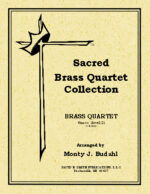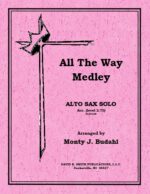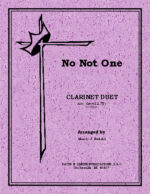-
-
-
What A Friend
$4.00A solo that begins with a brief introduction in the piano. The soloists then presents the tune in a straight-forward rendition. The second section presents the tune in the piano while the soloist overlays with a gentle obligato. The third section goes back to the melody briefly and then shifts back to the obligato and then settles into a final repose.
-
What A Friend
$4.00A solo that begins with a brief introduction in the piano. The soloists then presents the tune in a straight-forward rendition. The second section presents the tune in the piano while the soloist overlays with a gentle obligato. The third section goes back to the melody briefly and then shifts back to the obligato and then settles into a final repose.
-
Come Ye That Love the Lord
$7.00A brass quartet for two trumpets and two trombones with opt. parts for Fr. Horn and Baritone TC. The pieces begins with canonic entrances and then increases in activity. The first thematic statement is stately in a block harmonic structure. The parts then state the tune with others in an ornamental addition. A modulation takes place and the first tombone/horn states the theme while the others portray soft bell-tone like accompniment. A spirited entrance from low voices to higher in a fugal format coming to a final, majestic Coda marking a strong ending.
-
Saints Bound For Heaven
$7.00A brass quartet for two trumpets, horn, trombone/baritone (BC & TC) in cut-time. The introduction is based on thematic material in a Q&A format between the trumpet and trombone. The style is in a spritely march galop giving an never-ending sense of motion. The second section passes the motives between parts giving continued activity leading up to a transition and modulation. The third section is simple but expansive until it settles down to a sense of destination and then a quick conclusion.
-
Jesus Paid It All
$7.00A brass quartet scored for two trumpets and two trombones with optional horn and baritone parts. The piece is in some ways simplistic and at the same time quite profound. The first section is somewhat gentle with subtle countrapuntal movement. The second section is more declamatory and then comes to a quiet repose.
-
Come Thou Fount
$7.00A brass quartet for two trumpets and two trombones with opt. Fr. Horn and Baritone Treble Clef. It begins in unison and then breaks into four part harmony- all in a majestic style, continuing in that manner throughout the first verse. The second verse is a duet between the first trumpet and trombone. The next statement passes the tune around the various parts gaining in excitement. The final section is more solemn and then enhanced with bell-tone figures. The Coda is in a majestic conclusion.
-
Christmas Brass Quartet Collection
$15.95(2-tp, 2-Trb, hn/BH) -four pieces: Hark The Herald Angels It Came Upon A Midnight Clear; Angels We Have Heard On High; O Little Town Of Bethlehem
-
-
Leaning On The Everlasting Arms
$9.00This trio begins with a joyful piano introduction which leads into a three part harmonization of the instrumental parts. The second section is a lilting (waltz feeling) in block harmonization and then goes into a bell-tone rendition of the tune. A brief transition in a slower, expressive style comes to repose where it concludes in the joyful style that the piece began.
-
-
-
Power in the Blood
$8.00This trumpet trio with piano accompaniment is presented in a solid, determined manner. It makes a definitive statement in the “Power in the Blood” of Christ. The middle section changes meter while maintaining the character of the opening.
-
Leaning On The Everlasting Arms
$9.00This trio begins with a joyful piano introduction which leads into a three part harmonization of the instrumental parts. The second section is a lilting (waltz feeling) in block harmonization and then goes into a bell-tone rendition of the tune. A brief transition in a slower, expressive style comes to repose where it concludes in the joyful style that the piece began.
-
Power in the Blood
$6.00This trumpet duet with piano accompaniment is presented in a solid, determined manner. It makes a definitive statement in the “Power in the Blood” of Christ. The middle section changes meter while maintaining the character of the opening.
-
What A Friend
$5.00A duet for clarinet and saxophone that begins with a brief introduction in the piano. The clarinet then presents the tune in a straight-forward rendition with the saxophone supporting with a moving harmonization ending with a melodic line. The second section presents the tune in the saxophone while the clarinet overlays with a gentle obligato. The third section goes back to the structure of the beginning briefly and then shifts back to the obligato addition and then settles into a final repose.
-
What A Friend
$5.00A duet for flute and clarinet that begins with a brief introduction in the piano. The flute then presents the tune in a straight-forward rendition with the clarinet supporting with a moving harmonization ending with a melodic line. The second section presents the tune in the claeint while the flute overlays with a gentle obligato. The third section goes back to the structure of the beginning briefly and then shifts back to the obligato addition and then settles into a final repose.
-
Power in the Blood
$8.00This saxophone trio with piano accompaniment is presented in a solid, determined manner. It makes a definitive statement in the “Power in the Blood” of Christ. The middle section changes meter while maintaining the character of the opening.
-
Leaning On The Everlasting Arms
$9.00This trio begins with a joyful piano introduction which leads into a three part harmonization of the instrumental parts. The second section is a lilting (waltz feeling) in block harmonization and then goes into a bell-tone rendition of the tune. A brief transition in a slower, expressive style comes to repose where it concludes in the joyful style that the piece began.
-
Power in the Blood
$6.00This saxophone duet with piano accompaniment is presented in a solid, determined manner. It makes a definitive statement in the “Power in the Blood” of Christ. The middle section changes meter while maintaining the character of the opening.
-
No Not One
$6.00This saxophone duet is presented in a rather simple two part fashion. Subsequent verses engage contrapuntal diversity of the melody line versus the harmony. A stirring rendition for any venue.
-
Sunday School Parade
$4.50The effect of a parade coming and going… using: Jesus Loves The Little Children; Onward Christian Soldiers; I’ve Got the Joy, Joy, Joy
-
All The Way Medley
$4.50An accompanied clarinet duet which begins with a melodic motif and then presents the hymn tune in unison by the two parts. The chorus then breaks into a duet harmonization in a straight forward manner. The next section presents the first part in a melodically altered rendition with the second part answering in an obbligato like fashion. The middle section is a Q&A form with the piano dropping out, followed by a piano solo section. A modulation now gives rise to the second part acting as a solo, followed by another modulation where the first takes over as a soloist. Then another modulation where the two parts present the chorus in a straight duet section., where it remains until the end.
-
No Not One
$6.00This clarinet duet is presented in a rather simple two part fashion. Subsequent verses engage contrapuntal diversity of the melody line versus the harmony. A stirring rendition for any venue.

























